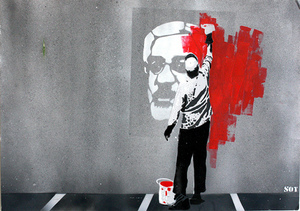Gallery unveils unexpected aspect of Iranian culture
Crewest Gallery, one of the many stops along the popular Downtown L.A. Art Walk, just opened its door to the youth of Iran with its newest exhibit, From the Streets of Iran: Works on Paper by Urban Artists from Iran. The exhibit highlights themes and images significant to young Iranians through the most unlikely of mediums: graffiti.
Although some might view graffiti as a form of public vandalism, Crewest Gallery values it as an art form. With its unique style, Crewest fits right in with the Art Walk crowd as a perspective art while also standing on its own as a modern and specifically urban creative vehicle. Primarily featuring street artists, the gallery caters to today’s generation, which is epitomized by the unconventional style of works it chooses to display.

Urban design · Downtown Los Angeles’ Crewest Gallery hosts the powerful, politically driven exhibit, From the Streets of Iran: Works on Paper by Urban Artists from Iran. The exhibit, which opens Thursday and runs until Sept. 26, features works from five young Iranian artists, each with their own distinct style. The works on display all revolve around the message of social justice. - Photos courtesy of Crewest Gallery
In a time when Americans are no strangers to the events occurring in Iran, From the Streets of Iran presents another perspective — this time from the young artists within the country, particularly centered around the Iranian elections held in June.
Just a short while ago, the media was bombarded with images from the Iranian election between Mahmoud Ahmadinejad, the conservative president, and Mir Hossein Mousavi, the former prime minister.
After Ahmadinejad’s contested landslide victory, a “green” revolution — the campaign color scheme for Mousavi — took hold of the country. It was a particularly popular buzz topic on social networking sites like Twitter, as avid web users turned their profile pictures green as an attempt to show their support for Mousavi and to highlight the injustice the elections perpetrated. It was a revolution that was truly motivated by Iran’s youth.
Enter the young urban artists from Iran. What better way to protest and reach an audience by tagging, spray painting and using stencil art on the sides of buildings, roads and bridges as their canvases? And though some works were painted before the election, the color green plays a definite role throughout the show.
Though not all the works in the gallery were created after the election, it’s evident Iran’s sudden turn of events was on the artists’ mind.
Right at the entrance, the artwork unfolds easily and themes of social justice, childhood, innocence, humor, despair and anger flow together yet stand separately. At first it is difficult to believe that five different artists, all in their early 20s, contributed to the exhibit. Yet even though each artist employs his own technique, it is the themes emphasized in each artist’s work that comes to define the youth of Iran.
Even though the works range from images of children in Africa to a picture of Che Guevara and Mona Lisa getting married, an important message that runs throughout the various pieces is social justice. Artists used graffiti to depict both the injustices occurring in their Iran and the simple joys that exist in the politically turbulent country. Even though in Iran graffiti is considered a political offense. CK1, one of the artists, was even detained for three days for displaying his art on walls. It is obvious from this showing and others that the objective of peace and social justice is more significant to each artist than anything else.
The artists further demonstrate their versatility by sampling works from other prolific artists, such as Andy Warhol, and photographs. The pieces can be as simple as a word like “hate” written in Farsi or “joyful” with the image of a child’s face colored with a peace sign. They can even be particularly seditious, like the image of a man painting over the image of Mousavi’s face. The works are complex, filled with an emotional depth that is provocative and at times a bit disturbing with its unabashed honesty.
Unlike other forms of protest or even artwork in Iran, the works of MAD, FRZ, ICY, CK1 and SOT are messages available to the public as a whole, even though the artists are under constant threat for displaying them. From the Streets of Iran expresses the importance of what the youth have to say in an art form that belongs specifically to their generation.
From the Streets of Iran: Works on Paper by Urban Artists from Iran will run from Sept. 10 to the 26 at the Crewest Gallery. The gallery is open Tuesday through Sunday. Visit www.crewest.com for more information.
